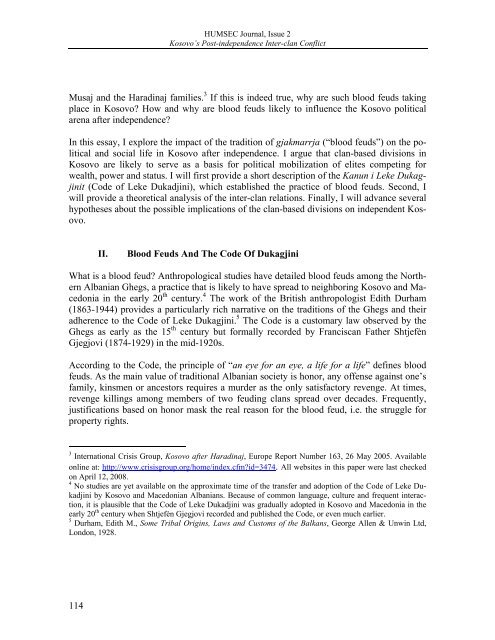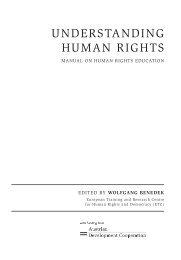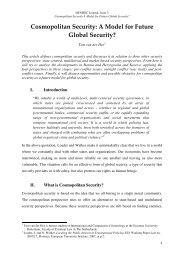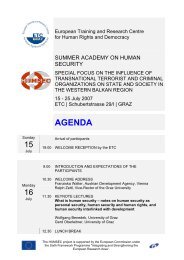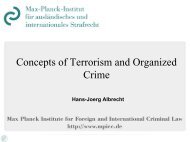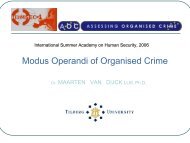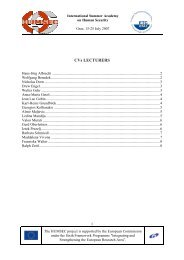Kosovo's Post-independence Inter-clan Conflict - HUMSEC
Kosovo's Post-independence Inter-clan Conflict - HUMSEC
Kosovo's Post-independence Inter-clan Conflict - HUMSEC
Create successful ePaper yourself
Turn your PDF publications into a flip-book with our unique Google optimized e-Paper software.
<strong>HUMSEC</strong> Journal, Issue 2<br />
Kosovo’s <strong>Post</strong>-<strong>independence</strong> <strong>Inter</strong>-<strong>clan</strong> <strong>Conflict</strong><br />
Musaj and the Haradinaj families. 3 If this is indeed true, why are such blood feuds taking<br />
place in Kosovo? How and why are blood feuds likely to influence the Kosovo political<br />
arena after <strong>independence</strong>?<br />
In this essay, I explore the impact of the tradition of gjakmarrja (“blood feuds”) on the political<br />
and social life in Kosovo after <strong>independence</strong>. I argue that <strong>clan</strong>-based divisions in<br />
Kosovo are likely to serve as a basis for political mobilization of elites competing for<br />
wealth, power and status. I will first provide a short description of the Kanun i Leke Dukagjinit<br />
(Code of Leke Dukadjini), which established the practice of blood feuds. Second, I<br />
will provide a theoretical analysis of the inter-<strong>clan</strong> relations. Finally, I will advance several<br />
hypotheses about the possible implications of the <strong>clan</strong>-based divisions on independent Kosovo.<br />
II. Blood Feuds And The Code Of Dukagjini<br />
What is a blood feud? Anthropological studies have detailed blood feuds among the Northern<br />
Albanian Ghegs, a practice that is likely to have spread to neighboring Kosovo and Macedonia<br />
in the early 20 th century. 4 The work of the British anthropologist Edith Durham<br />
(1863-1944) provides a particularly rich narrative on the traditions of the Ghegs and their<br />
adherence to the Code of Leke Dukagjini. 5 The Code is a customary law observed by the<br />
Ghegs as early as the 15 th century but formally recorded by Franciscan Father Shtjefėn<br />
Gjegjovi (1874-1929) in the mid-1920s.<br />
According to the Code, the principle of “an eye for an eye, a life for a life” defines blood<br />
feuds. As the main value of traditional Albanian society is honor, any offense against one’s<br />
family, kinsmen or ancestors requires a murder as the only satisfactory revenge. At times,<br />
revenge killings among members of two feuding <strong>clan</strong>s spread over decades. Frequently,<br />
justifications based on honor mask the real reason for the blood feud, i.e. the struggle for<br />
property rights.<br />
3 <strong>Inter</strong>national Crisis Group, Kosovo after Haradinaj, Europe Report Number 163, 26 May 2005. Available<br />
online at: http://www.crisisgroup.org/home/index.cfm?id=3474. All websites in this paper were last checked<br />
on April 12, 2008.<br />
4 No studies are yet available on the approximate time of the transfer and adoption of the Code of Leke Dukadjini<br />
by Kosovo and Macedonian Albanians. Because of common language, culture and frequent interaction,<br />
it is plausible that the Code of Leke Dukadjini was gradually adopted in Kosovo and Macedonia in the<br />
early 20 th century when Shtjefėn Gjegjovi recorded and published the Code, or even much earlier.<br />
5 Durham, Edith M., Some Tribal Origins, Laws and Customs of the Balkans, George Allen & Unwin Ltd,<br />
London, 1928.<br />
114


